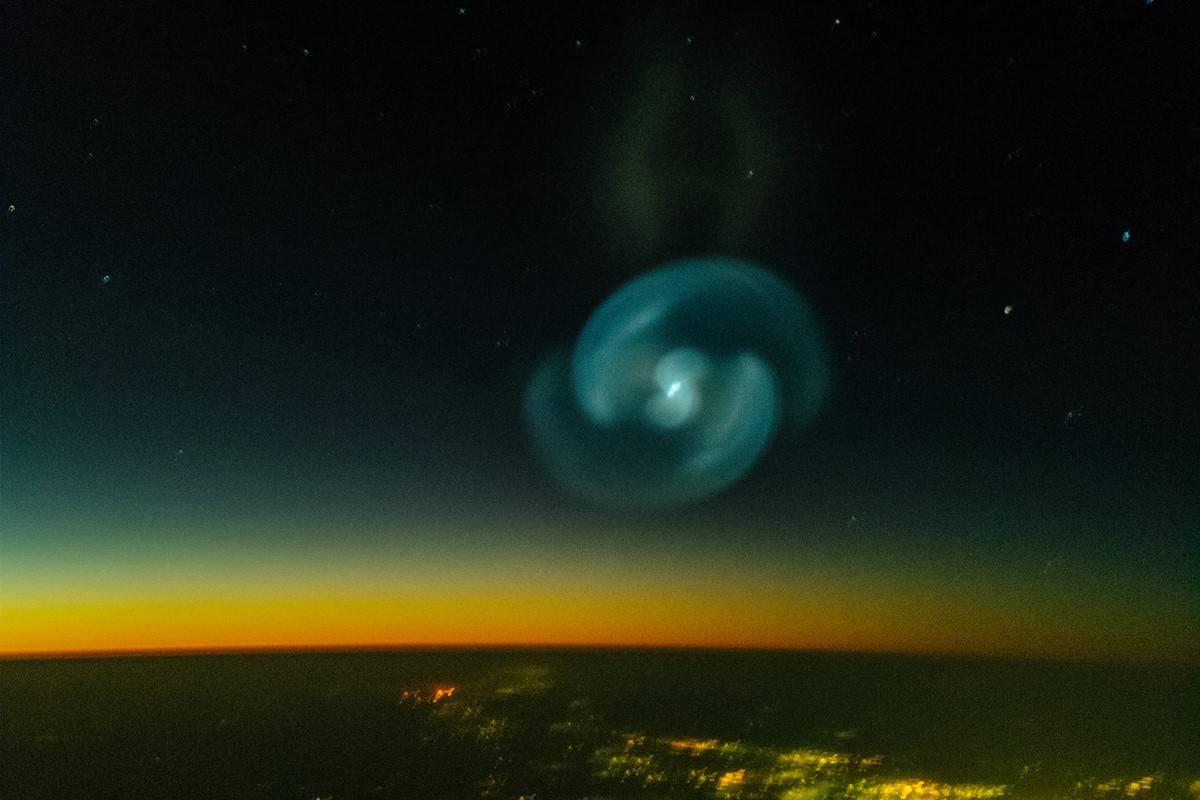Strange Sky Spiral May Come from Secretive SpaceX Zuma Launch

A pair of spectacular images of an ethereal spiral in the night sky may show the upper stage of a SpaceX Falcon 9 rocket after it launched a secret satellite for the U.S. government on Sunday night (Jan. 7).
The photos, posted on Twitter, show a brilliant spiral that appeared in the night sky shortly after a SpaceX Falcon 9 rocket launched the Zuma satellite on a mystery mission for the U.S. government. Some media reports, citing anonymous government officials, have reported that the Northrop Grumman-built Zuma spacecraft may have failed after it launched into orbit. SpaceX representatives have said their Falcon 9 rocket performed as expected during the Zuma launch. A Northrop Grumman representative said the company cannot comment on the mission due to its classified nature. [See amazing photos of SpaceX's Zuma launch]
One photo, taken by Dutch pilot Peter Horstink, shows a dazzling aerial view of an object in the sky, taken as Horstink flew on a freighter aircraft. The object appears as a greenish-blue spiral, seen as Horstink flew 35,000 feet (11,000 meters) above the Earth's surface near the city of Khartoum, Sudan, according to veteran satellite tracker Marco Langbroek, who posted the photo on Twitter.
Langbroek said both photos show what appears to be a normal venting of excess fuel by the upper stage of the SpaceX's Falcon 9 rocket after separating from its payload. Such venting procedures are typical after launches, done to avoid explosions after spacecraft separation, Langbroek wrote on his satellite-tracking website.
Another photo in Sudan, posted to Twitter by Sam Cornwell, shows a view of the spiral from the ground.
SpaceX launched the secret Zuma spacecraft on Sunday night from the company's Space Launch Complex 40 pad at Cape Canaveral Air Force Station in Florida. The spacecraft was built by Northrop Grumman for a U.S. government agency, but which agency that is has not yet been revealed.
The mission was SpaceX's first launch of 2018 and the company's third classified launch for the U.S. government. In May 2017, SpaceX launched a classified spy satellite for the U.S. National Reconnaissance Office, following that in September with the launch of an X-37B robotic space plane on a secret mission for the U.S. Air Force. The X-37B space plane is still in orbit on its classified OTV-5 mission.
Get the Space.com Newsletter
Breaking space news, the latest updates on rocket launches, skywatching events and more!
Email Tariq Malik at tmalik@space.com or follow him @tariqjmalik and Google+. Follow us @Spacedotcom, Facebook and Google+. Original article on Space.com.
Join our Space Forums to keep talking space on the latest missions, night sky and more! And if you have a news tip, correction or comment, let us know at: community@space.com.

Tariq is the Editor-in-Chief of Space.com and joined the team in 2001, first as an intern and staff writer, and later as an editor. He covers human spaceflight, exploration and space science, as well as skywatching and entertainment. He became Space.com's Managing Editor in 2009 and Editor-in-Chief in 2019. Before joining Space.com, Tariq was a staff reporter for The Los Angeles Times covering education and city beats in La Habra, Fullerton and Huntington Beach. In October 2022, Tariq received the Harry Kolcum Award for excellence in space reporting from the National Space Club Florida Committee. He is also an Eagle Scout (yes, he has the Space Exploration merit badge) and went to Space Camp four times as a kid and a fifth time as an adult. He has journalism degrees from the University of Southern California and New York University. You can find Tariq at Space.com and as the co-host to the This Week In Space podcast with space historian Rod Pyle on the TWiT network. To see his latest project, you can follow Tariq on Twitter @tariqjmalik.









